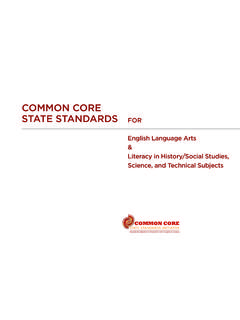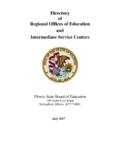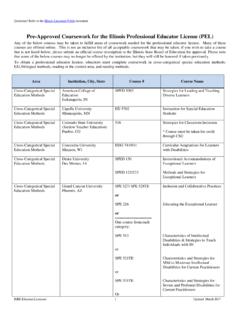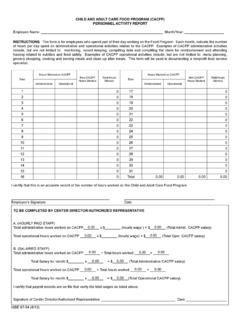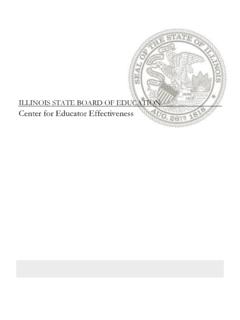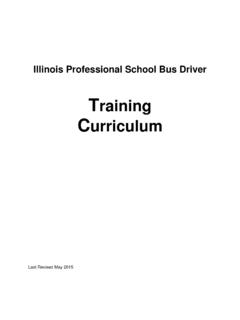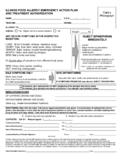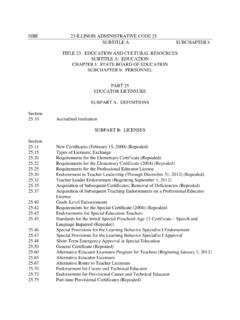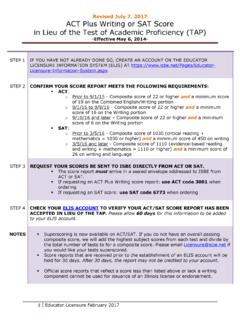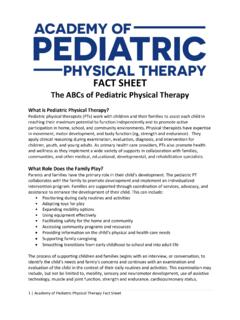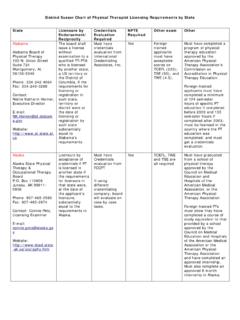Transcription of RECOMMENDED PRACTICES FOR OCCUPATIONAL AND …
1 RECOMMENDED PRACTICES . FOR OCCUPATIONAL AND. physical therapy SERVICES IN. ILLINOIS SCHOOLS. 2019. OT & PT Coordinator Consortium of Northern Illinois (Updated from 2003 document published by the ILLINOIS STATE BOARD OF EDUCATION ). TABLE OF CONTENTS. INTRODUCTION AND 4. TERMINOLOGY AND ABBREVIATIONS .. 6. SECTION I OVERVIEW OF OCCUPATIONAL therapy AND physical therapy AS. RELATED SERVICES .. 8. A. INTRODUCTION .. 8. B. LEGISLATIVE OVERVIEW .. 8. Table 1. Federal Legislation/Regulations Impacting Special 8. Table 2. State Law/Rules/Policy Impacting Special Education .. 9. Table 3. Review of Section 504, ADA, Implementing Regulations, and C. RECORDS OF STUDENT PERFORMANCE ..11. SCHOOL STUDENT RECORDS ..11. GUIDELINES FOR DOCUMENTATION ..14. Table 4. Legal References for Documentation Requirements ..15. D. DESCRIPTION OF therapy PRACTITIONERS ..16. OCCUPATIONAL therapy ..16. Table 5. Educational Background of OT Practitioners ..17. physical therapy ..18. Table 6. Educational Background of PT Practitioners.
2 19. E. OT AND PT IN THE EDUCATIONAL ENVIRONMENT ..21. Table 7. Common Educational Services in School Practice ..22. SECTION II DETERMINATION OF THE NEED FOR AND PROVISION OF therapy ..24. A. B. SYSTEMS LEVEL THERAPISTS AS MEMBERS OF EDUCATIONAL MTSS/RtI AND EARLY INTERVENING INITIATIVES ..26. Figure 1. Three-Tier Model of School ROLE OF OT AND PT IN MTSS/RtI ..27. Figure 2. The Role of the Therapist in an MTSS/RtI Model..27. IMPACT OF LICENSURE ON PROVISION OF OT SERVICES UNDER AN MTSS/RtI. MODEL ..28. IMPACT OF LICENSURE ON PROVISION OF PT SERVICES UNDER AN MTSS/RtI. MODEL ..29. C. OVERVIEW OF FAPE ..32. D. OT AND PT AS PART OF THE SPECIAL EDUCATION CHILD FIND ..33. 1. NEEDS ASSESSMENT (DOMAIN)..35. OT AND PT AS PART OF THE EVALUATION PROCESS ..37. DOCUMENTATION OF EVALUATION RESULTS ..39. ELIGIBILITY DETERMINATION ..40. E. THE ROLE OF OT and PT PRACTITIONERS IN THE FORMULATION OF THE IEP ..41. IEP TO OFFER A FAPE ..41. IEP PLANNING AND DEVELOPMENT ..41. IEP COMPONENTS ..42.
3 IEP GOAL DEVELOPMENT ..44. DETERMINING THE NEED FOR OT AND/OR PT SERVICES ..46. ENTRANCE GUIDELINES ..47. DETERMINATION OF MINUTES (FREQUENCY/DURATION/LOCATION) ..47. PARTICIPATION IN STATE ASSESSMENT (TESTING)..48. PLACEMENT ..48. EXTENDED SCHOOL YEAR (ESY) ..51. SCHOOL TRANSITIONS AND TRANSITION SERVICES ..51. DISCHARGE/TERMINATION OF SCHOOL-BASED therapy SERVICES ..53. F. FORMULATION AND IMPLEMENTATION OF OT AND PT INTERVENTION ..54. INTERVENTIONS WITH THE STUDENT OR DIRECT INTERVENTION ..55. INTERVENTIONS ON BEHALF OF THE STUDENT OR CONSULTATIVE/. COLLABORATIVE INTERVENTION AND OTHER INDIRECT ACTIVITIES ..56. INTERVENTION STRATEGIES/TECHNIQUES FOR IEP DEVELOPMENT AND. IMPLEMENTATION ..59. COLLABORATION WITH TEAMS ..60. COACHING AND TRAINING ..60. DATA COLLECTION/PROGRESS MONITORING ..60. G. REFERRALS (PRESCRIPTIONS), DOCUMENTATION (SERVICE LOGS) AND. MEDICAID COST RECOVERY ..63. H. OT AND PT AS PART OF THE SECTION 504 PROCESS ..64. I. INDIVIDUAL SERVICE PLANS AND PROPORTIONATE SHARE SECTION III ADMINISTRATIVE CONSIDERATIONS.
4 70. A. INTRODUCTION ..70. B. EMPLOYMENT, RETENTION, AND RECRUITMENT EMPLOYMENT ARRANGEMENTS. AND AGENCIES ..70. RECRUITMENT AND RETENTION METHODS ..70. INTERVIEW PROCESS ..72. ORIENTATION OF NEW STAFF ..73. UNIONS ..73. C. CONTINUING EDUCATION ..73. 2. D. SPACE, EQUIPMENT, AND PLANNING FOR SERVICE DELIVERY, WORKSPACE. STANDARDS AND GUIDELINES ..74. THERAPEUTIC ADAPTIVE EQUIPMENT ..75. FACILITIES PLANNING ..76. E. WORKLOAD DETERMINATION ..77. WORKLOAD VARIABLES ..78. F. SUPERVISION AND MANAGEMENT OF therapy PERSONNEL ..80. PERFORMANCE EVALUATIONS ..81. SUPERVISION OF OTAs AND PTAs ..82. LEGAL REFERENCES ..85. PROFESSIONAL OTHER RESOURCES ..97. ACKNOWLEDGEMENTS ..99. ENDNOTES ..102. 3. INTRODUCTION AND PURPOSE. The Illinois State Board of Education published the original version of the RECOMMENDED PRACTICES for OCCUPATIONAL and physical therapy Services in Illinois Schools in The educational system and approaches for all students as well as special education federal and State laws, rules, and regulations regarding students with disabilities have evolved since that time.
5 Some of the recent changes include Multi-tiered System of Support (MTSS)/Response to Intervention (RtI), the need for a physician's referral, inclusion of functional skill goal areas along with academic goals and the requirement for transition services. In addition, service plans and proportionate share funding and obligations, guidelines for documentation, workload parameters, and the direction to provide integrated interventions have been more clearly defined. The concept of all students being educated in the least restrictive environment has been emphasized. This includes making sure that academic expectations are rigorous for students with disabilities. The original purpose of the 2003 document was to present administrators, OT and/or PT. personnel, educators, other professionals, and parents/guardians with information regarding the provision of OT and/or PT in educational environments. This updated document is intended to serve as guidance so that each Local Education Agency (LEA).
6 Employing therapy Practitioners can establish or update agency procedures for providing OT and/or PT services within the educational setting. Supervisors of OT and PT. departments and therapy Practitioners should have access to and be knowledgeable of the most current resources. We hope this document will serve as one such resource in addition to the many resources shared. Another purpose is to provide Illinois school administrators and therapy Practitioners with a sound source of information to follow when serving students with special needs in the school setting. It includes the most salient statutory provisions and best PRACTICES for therapy Practitioners working in schools. This updated document is also intended to provide useful guidance to many other stakeholders of school-based OT and PT services, including but not limited to other school personnel, educators in university programs who prepare students to become therapy Practitioners, and individuals studying to become therapy Practitioners.
7 A consortium of OT and PT coordinators spearheaded a rigorous review of the 2003. document to revise this document with the most relevant and updated resources, changes to federal and State law, and current best PRACTICES in school-based OT and PT. services. A committee was comprised of fifteen OTs and PTs in leadership positions from multiple school districts and special education cooperatives throughout Illinois as well as three professors in universities educating OT and PT students, who had formerly worked in school-based practice. The committee completed a thorough review of the 2003. document, which included comparing the document to other states' guidelines for OTs and PTs in schools, having subcommittees complete a review and revision of each section, second and third readings of the document by the whole committee, a review of the revised document by two tiers of professors with expertise in these areas, and additional review and editing by committee leaders and attorneys retained by the consortium.
8 4. Information provided herein is based upon standards of practice defined by the Illinois OCCUPATIONAL therapy Practice Act, the Illinois physical therapy Act, the American OCCUPATIONAL therapy Association (AOTA), and the American physical therapy Association (APTA), as well as the requirements set forth in various federal and State law governing LEAs. Please refer to the References and Legal References sections for detailed information about the resources used to update this document. Inherent in this document are the following assumptions: Students with disabilities must be served in the least restrictive environment appropriate to meet their individual needs. The educational needs of the student related to their participation in their educational program define the student's need for OT and/or PT services. The education environment is the setting where a student engages in his/her educational program activities. Therefore, therapeutic interventions should be implemented within the educational environment (including, but not limited to, classroom, lunchroom, bathroom, hallways, playground, vocational sites, etc.)
9 While various aspects of student function may be assessed by professionals trained in various disciplines ( , OCCUPATIONAL therapists, physical therapists, psychologists, general education and special education teachers, and physical education teachers), OCCUPATIONAL therapists and physical therapists assess various aspects of functioning and adaptive abilities from their unique perspectives as described in this document. Even though OT and PT sometimes overlap, they are separate disciplines with distinct entry-level educational experiences and separate licensure laws. OT and PT services must both be available to students in the educational environment based on identified student need. Equal availability of both OT and PT service is assumed. 2. DISCLAIMER: This document is for informational purposes only and not for the purpose of providing legal advice, and it does not guarantee compliance with law or applicable standards of practice. While efforts have been made to provide only accurate and current information as of the date of publication, laws and best PRACTICES are constantly changing.
10 Individuals using this document should contact the Department of Education, the Illinois State Board of Education, AOTA, APTA, and/or the LEA's attorney to obtain advice about a particular issue or problem. 5. TERMINOLOGY AND ABBREVIATIONS. The following terminology is used generally throughout this guidance: Episode of care means the managed care provided for a specific problem or condition during a set time period and can be given either for a short period or on a continuous basis, or it may consist of a series of intervals marked by one or more brief separations from care. 3. Integrated practice refers to the various activities conducted within the general education curriculum or the naturally occurring activities within the school day and school- related activities by therapy Practitioners as part of school-based OCCUPATIONAL therapy and physical therapy . Intervention means services, strategies, supports, and other activities by therapy Practitioners with or on behalf of students in the school setting.
